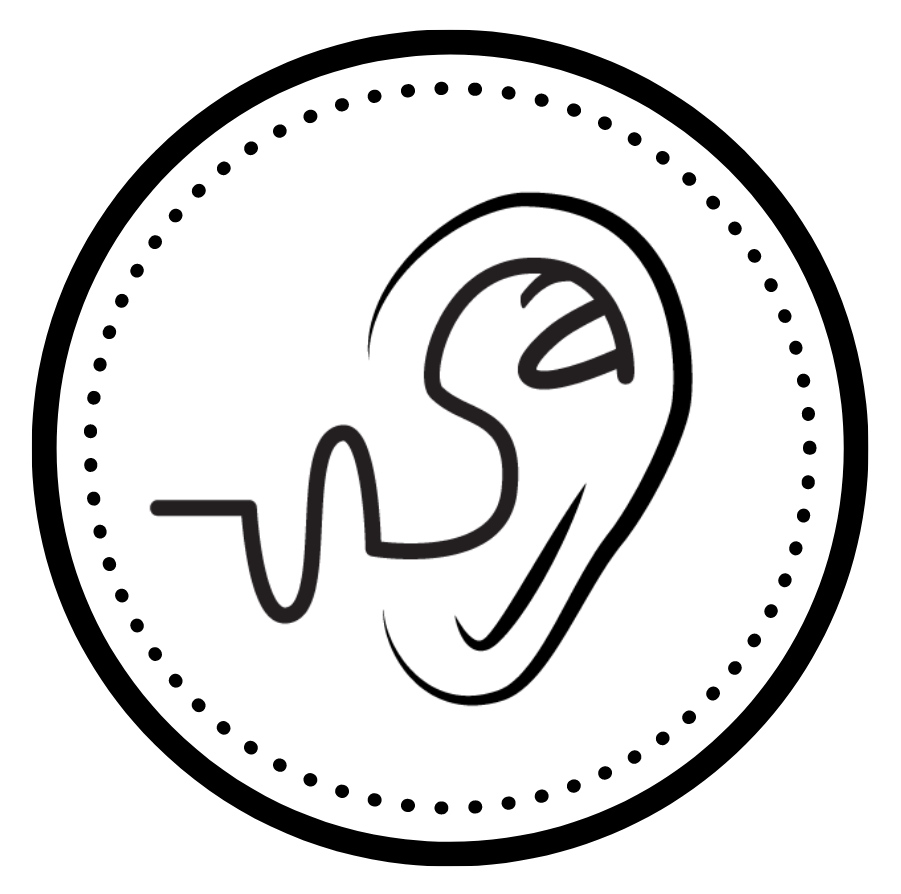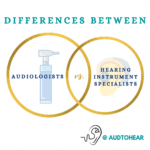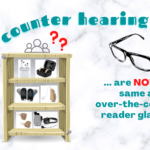Assumption #1: We know (American) sign language
When I tell people that I’m an audiologist, one of the first follow up questions they ask is, “Does that mean you know sign language?”
Kinda makes sense right…? The common person might associate hearing loss with deafness with using sign language.
Sadly, the answer to this question is nope. Audiologists work extensively with people with hearing loss, but that does not mean every audiologist knows sign language. Some audiologists grow up signing or they might elect to learn sign in school/college. In most cases, audiologists work with individuals who develop hearing loss after using spoken language for many years (post lingual deafness). Or, audiologists work with families and children with hearing loss whose primary goal is to develop spoken language.
Personally, I took a couple ASL courses in college and can fingerspell. I might recognize some sign vocabulary, but I am the farthest thing from being fluent enough to hold a conversation. And for those of you familiar with sign language, fingerspelling your way through a conversation is tedious and not an efficient way of communicating your thoughts.
Sign language is beautiful and so fun to learn. It is also a great skill to have and use with spoken language. It is not a requirement to know sign language to work as an audiologist (the exception is probably for audiologists employed at Deaf-friendly schools/programs/clinics).
Assumption #2: We have a magic cure to fix hearing loss and tinnitus
Unless you have an obvious and treatable conductive hearing loss (e.g. ear wax impaction, atresia, acute ear infection), nothing can be done to “fix” your hearing loss. The tinnitus (e.g. ringing, buzzing, humming, whooshing sound) in your ear might never go away. There is no treatment for permanent, sensorineural hearing loss and the tinnitus that compliments your progressive hearing loss.
Audiologists are not magicians and we cannot cure hearing loss. If we could, we would make millions and would probably have to retire our profession.
Although we can’t fix hearing loss or tinnitus, audiologists can help you manage the challenges you come across as a result of having hearing loss. The bulk of what we do besides diagnostic testing is counsel you through what it means to have hearing loss and what your options are to improve your speech understanding ability. Our knowledge from hearing research, patient experiences, and conversations with colleagues guide our recommendations to help you reconnect with the world.
In most cases, wearing hearing aids is the best recommendation we can give to improve your hearing ability. In addition to that, we offer tools and resources over time to support the everyday challenges of navigating communication in noisy, social settings. Be prepared to discuss specifics about situations where you want to hear better because that’s how your audiologist will learn how to tailor the conversation to help you.
Assumption #3: We are “just” a technician or hearing aid person
Absolutely not. There’s more to an audiologist’s job than being able to push a few buttons on our audiometer. Audiologists don’t invest over $100k into getting a doctorate degree only to be treated as a technician. It’s offensive and I make it known to my patients that I am more than just a “hearing aid lady”. This is where we have to educate our patients and friends about what it means to be an audiologist because they aren’t able to peek into our brain.
There’s nothing wrong with being a technician if that’s what your job involves. Nowadays, most audiologists have a Doctorate of Audiology (Au.D.) degree and that means they have undergone rigorous training. Our training makes us experts at understanding hearing loss and what can be done about it. Our training shaped us to think critically about implementing new technologies and deal with issues that come up in clinical practice.
Audiologists are constantly putting pieces of a puzzle together to figure out what each patient is all about. We may consult with other healthcare professionals to help us (through referrals) because sometimes a patient’s symptoms requires more than just audiology services. It really just depends and we have to think about the bigger picture to help our patients resolve their concerns.
Assumption #4: We can double as a marriage counselor/therapist
No way. We work with couples where both parties have hearing loss. We also work with couples where only one person has hearing loss, the other person has very good or normal hearing perception. Sure, we do our best to educate spouses and partners about how to communicate with each other, but the lines get blurry f a s t.
This is especially true when there are clearly other unresolved issues that can lead to miscommunication even when hearing loss is not part of the picture. Remember that CLEAR communication is the key to a successful relationship. If a patient was having communication issues with their partner for years prior to the onset of their hearing problems, then it sure doesn’t help that progressive hearing loss affecting one or both parties is now thrown into the mix.
As an audiologist, it is so interesting to observe the power dynamics within a partnership.
Our role focuses on the act of communication and how to repair communication breakdowns. We can talk about how to communicate your needs to improve speech understanding, but it’s the other stuff. You know, the emotions of frustration, anger, stress, resentment, and detachment associated with the consequences of hearing loss. The emotional stuff is going to require talking with a real, licensed marriage counselor to work through. Hearing loss is the silent killer of relationships, so couples may need to assess whether there are bigger issues to resolve.
Assumption #5: We have a one size fits all approach
Not at all. I always say that no two patients are the same. A hearing test or audiogram can give us some idea of how well a patient can hear by the severity and type of hearing loss they have. However, how they process sound information can be entirely different. How they function in social settings can be entirely different. How they perceive their hearing loss can be entirely different.
For example, 37 year old Mrs. Smith’s audiogram looks like this: 
Mrs. Smith is a project manager at an engineering company and she is constantly working with contractors over the phone, one-on-one meetings, and in large group presentations. She lives with her husband and 2 young toddlers. She reports that she has withdrawn from social outings because she’s “too tired from work to engage with friends”. Background noise is bothersome for her and she has a hard time following conversations unless it’s a conversation with the person sitting next to her.
On the other hand, 82 year old Mr. Lee’s audiogram also looks like this: 
Mr. Lee is a retired gentleman residing in an assisted living facility. He plays BINGO every Wednesday night with his buddies and he usually doesn’t notice any difficulty hearing the announcer. Otherwise, he spends most of his time watching TV in his apartment. His son reports that the patient’s TV is turned up too loudly, but Mr. Lee thinks the volume is just right.
Two very different patient histories with essentially the same hearing loss.
Who do you think struggles more with their hearing loss?
We ask questions. We listen. We formulate impressions before we dig through our toolbox to figure out how to create a hearing loss management plan for you. Audiologists don’t always have answers to everything, but we are willing to work with you to come up with solutions. Your hearing loss, your challenges, your experiences – they’re all specific and unique to you. It only makes sense that your audiologist recognizes your individuality when discussing your options.
Assumption #6: We charge $$$ for hearing aids because we think you’re made of money
This is not true. I can’t and won’t speak for every practice, clinic, or audiologist on this issue, but I will say that hearing aids seem ridiculously expensive because pricing to the customer/patients is not always transparent. Many places “bundle” the cost of hearing devices and professional services into a dollar amount, which can be deceiving because patients think that what they’re paying for is the physical products they receive.
Unfortunately, hearing aids are $$$ because of all the intangible components. The researchers and engineers who design the operating sound processing technology within the hearing aids have to be paid. The hearing aid manufacturers have to be paid. The rent, electricity bill, and equipment at the clinic you’re visiting have to be paid. The audiologists and supporting staff whose time is spent on making sure the patients’ experience is remarkable have to be paid.
Revenue from hearing aid sales are necessary to keep a business afloat. Most ethical dispensers and audiologists don’t want to charge you an arm and a leg to help you be able to hear better, but the truth is, the pricing is based on the expenses incurred as a result of managing a business.
I would encourage you to shop around for hearing aids that are suitable for your budget. Private clinics, hospitals, big box stores – they all operate differently and offer different price points. Ask questions about how different technologies can improve your listening needs. Over the counter (OTC) hearing aids are starting to penetrate the market, so you’ll have more options than ever before.
Just remember: you get what you pay for.
Does your provider offer genuine care and have good intentions to follow up with you after your purchase? If you’re unsatisfied with your hearing aid purchase, return them before the end of your trial period. All states have laws that protect consumers’ rights, so be aware of the purchasing terms.
Final thoughts
Audiologists can do a lot of things related to the ear and balance system, but our scope of practice is limited in that we are not medical physicians. We are rehabilitation specialists and the bulk of what we do involves counseling. The above assumptions about audiologists may be reasons why people don’t seek out hearing healthcare.
Patients talk to us about their hearing and communication challenges. Parents discuss concerns for their child growing up with hearing loss. Caregivers share their observations about how their loved one struggles to engage in conversations. Adult children notice when their parents don’t hear the phone ring or that the TV is turned up too loudly.
Audiologists listen and provide education about what can be done to empower patients in those challenging listening situations. We provide a shoulder to lean on when caregivers are frustrated and want to help someone they love navigate the challenges of his/her/their hearing loss. In a perfect world, no one struggles to socialize and make meaningful connections with people around them. But in this world, socializing can be a huge adversity for people living with hearing loss. We hear you. And we want to help.





A couple of improvements you can make:
I would actually put the Disclaimer and Private Policy in the footer instead of the main menu. If you don’t take this advice, do this instead: https://www.audtohear.com/about-me/ should be a dropdown link in the ‘About Me’ dropdown. People won’t know to click on ‘About Me’ to get to this page…they see the dropdown and think there are only two options.
There’s a lot of clutter on the website. I would get rid of the Keyword Research bar on the right pane and add it on the header bar. It’s there already, but maybe make it automatically expanded by default.
I would make the menu bar responsive so that when you scroll down, it appears at the top and stays there. If you do this, you can get rid of the Categories on the right pane.
Center your images in every post. This post in particular doesn’t have a centered image.
On your main home page, the ‘Meet Dr. Janice Vong | Audiologist’ introduces a lot of white space. I would get rid of it and put it above the Newsletter on the right pane. It would be for better branding because it’s going to appear on every page.
Thanks for the feedback! 🙂